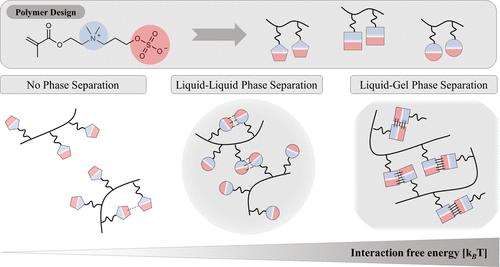相分离倾向可调两性离子聚合物的合理设计
IF 5.2
1区 化学
Q1 POLYMER SCIENCE
引用次数: 0
摘要
两性离子聚合物正在成为形成流体状凝聚体的有希望的候选者,具有理想的特性,包括防污能力、刺激响应性和生物相容性。这些特性使它们在生物医学领域的应用特别有吸引力,包括生物分离、生化分析和诊断。然而,目前还没有明确的指导原则来预测两性离子聚合物的相分离行为,并为新型相分离聚合物的设计提供指导。在这项研究中,我们开发了一种结合分子动力学模拟、理论和实验的工作流程,以预测两性离子聚合物的相分离倾向,以及所得凝聚物的材料特性。通过合成无需相分离、液-液相分离或液-凝胶相分离的新型两性离子聚合物,我们验证了基于模拟的工作流程作为预测工具。除了预测能力之外,我们还表明,分子模拟提供了对由不同官能团介导的有吸引力的同型分子间相互作用的见解,合理化了两性离子单体之间观察到的巨大差异,这些差异表现出最小的结构变化。我们的方法为控制不同两性离子聚合物相分离的分子原理提供了有价值的见解,对其材料的设计具有重要意义。本文章由计算机程序翻译,如有差异,请以英文原文为准。

Rational Design of Zwitterionic Polymers with Tunable Phase Separation Propensity
Zwitterionic polymers are emerging as promising candidates for forming fluid-like coacervates with desirable characteristics, including antifouling capabilities, stimulus responsiveness, and biocompatibility. These attributes make them particularly appealing for applications in the biomedical field, including bioseparation, biochemical analysis, and diagnostics. However, there are currently no clear guiding principles for predicting the phase separation behavior of zwitterionic polymers and informing the design of novel phase-separating polymers. In this study, we develop a workflow that combines molecular dynamics simulations, theory, and experiments to predict the phase separation propensity of zwitterionic polymers, as well as the material properties of the resulting coacervates. We validate our simulation-based workflow as a predictive tool by synthesizing new zwitterionic polymers that undergo no phase separation, liquid–liquid phase separation, or liquid–gel phase separation. Beyond their predictive power, we show that molecular simulations provide insights into the attractive homotypic intermolecular interactions mediated by distinct functional groups, rationalizing the large differences observed between zwitterionic monomers that exhibit minimal structural variations. Our approach provides valuable insights into the molecular principles governing the phase separation of distinct zwitterionic polymers, with important implications for the design of their materials.
求助全文
通过发布文献求助,成功后即可免费获取论文全文。
去求助
来源期刊

Macromolecules
工程技术-高分子科学
CiteScore
9.30
自引率
16.40%
发文量
942
审稿时长
2 months
期刊介绍:
Macromolecules publishes original, fundamental, and impactful research on all aspects of polymer science. Topics of interest include synthesis (e.g., controlled polymerizations, polymerization catalysis, post polymerization modification, new monomer structures and polymer architectures, and polymerization mechanisms/kinetics analysis); phase behavior, thermodynamics, dynamic, and ordering/disordering phenomena (e.g., self-assembly, gelation, crystallization, solution/melt/solid-state characteristics); structure and properties (e.g., mechanical and rheological properties, surface/interfacial characteristics, electronic and transport properties); new state of the art characterization (e.g., spectroscopy, scattering, microscopy, rheology), simulation (e.g., Monte Carlo, molecular dynamics, multi-scale/coarse-grained modeling), and theoretical methods. Renewable/sustainable polymers, polymer networks, responsive polymers, electro-, magneto- and opto-active macromolecules, inorganic polymers, charge-transporting polymers (ion-containing, semiconducting, and conducting), nanostructured polymers, and polymer composites are also of interest. Typical papers published in Macromolecules showcase important and innovative concepts, experimental methods/observations, and theoretical/computational approaches that demonstrate a fundamental advance in the understanding of polymers.
 求助内容:
求助内容: 应助结果提醒方式:
应助结果提醒方式:


